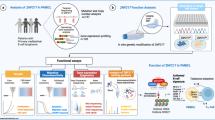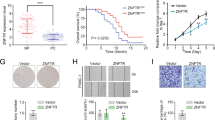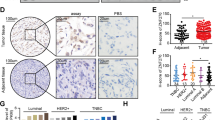Abstract
Zinc-finger protein 217 (ZNF217) is a Kruppel-like zinc-finger protein located at 20q13.2, within a region of recurrent maximal amplification. Here, we demonstrate that ZNF217 is a transcriptional repressor protein and report the purification and characterization of a ZNF217 complex. The purified ZNF217 complex consists of approximately six proteins and contains the transcriptional co-repressors CoREST, BHC110/LSD1, histone deacetylase (HDAC) 2 and C-terminal binding protein (CtBP1). The purified ZNF217 complex possesses deacetylase activity as well as lysine 4 histone H3-specific demethylase activity that is most likely mediated by the BHC110/LSD1 component. To determine if ZNF217 is a sequence-specific binding protein, we have made use of cyclic amplification and selection of targets (CAST) assay and identify for the first time a ZNF217 DNA consensus recognition sequence (CRS) that is highly conserved in the human E-cadherin promoter. Chromatin immunoprecipitation (ChIP) experiments demonstrate that ZNF217, as well as the other components of the ZNF217 complex, are found on the region of the proximal E-cadherin promoter that contains the identified ZNF217 CRS in vivo. Using a combination of transient transfections and small interfering RNA, we demonstrate that ZNF217 represses the E-cadherin promoter. Collectively, our results implicate ZNF217 and its associated proteins in a novel pathway that may have profound effects on cancer progression.
This is a preview of subscription content, access via your institution
Access options
Subscribe to this journal
Receive 50 print issues and online access
$259.00 per year
only $5.18 per issue
Buy this article
- Purchase on SpringerLink
- Instant access to full article PDF
Prices may be subject to local taxes which are calculated during checkout






Similar content being viewed by others
References
Andres ME, Burger C, Peral-Rubio MJ, Battaglioli E, Anderson ME, Grimes J et al. (1999). CoREST: a functional corepressor required for regulation of neural-specific gene expression. Proc Natl Acad Sci USA 96: 9873–9878.
Ausubel FM . (2002). Current Protocols in Molecular Biology. John Wiley: New York.
Batlle E, Sancho E, Franci C, Dominguez D, Monfar M, Baulida J et al. (2000). The transcription factor snail is a repressor of E-cadherin gene expression in epithelial tumour cells. Nat Cell Biol 2: 84–89.
Bukholm IK, Nesland JM, Borresen-Dale AL . (2000). Re-expression of E-cadherin, alpha-catenin and beta-catenin, but not of gamma-catenin, in metastatic tissue from breast cancer patients. J Pathol 190: 15–19.
Cano A, Perez-Moreno MA, Rodrigo I, Locascio A, Blanco MJ, del Barrio MG et al. (2000). The transcription factor snail controls epithelial–mesenchymal transitions by repressing E-cadherin expression. Nat Cell Biol 2: 76–83.
Chinnadurai G . (2002). CtBP, an unconventional transcriptional corepressor in development and oncogenesis. Mol Cell 9: 213–224.
Collins C, Rommens JM, Kowbel D, Godfrey T, Tanner M, Hwang SI et al. (1998). Positional cloning of ZNF217 and NABC1: genes amplified at 20q13.2 and overexpressed in breast carcinoma. Proc Natl Acad Sci USA 95: 8703–8708.
Collins C, Volik S, Kowbel D, Ginzinger D, Ylstra B, Cloutier T et al. (2001). Comprehensive genome sequence analysis of a breast cancer amplicon. Genome Res 11: 1034–1042.
Comijn J, Berx G, Vermassen P, Verschueren K, van Grunsven L, Bruyneel E et al. (2001). The two-handed E box binding zinc finger protein SIP1 downregulates E-cadherin and induces invasion. Mol Cell 7: 1267–1278.
Dellaire G, Makarov EM, Cowger JJ, Longman D, Sutherland HG, Luhrmann R et al. (2002). Mammalian PRP4 kinase copurifies and interacts with components of both the U5 snRNP and the N-CoR deacetylase complexes. Mol Cell Biol 22: 5141–5156.
Elrod-Erickson M, Pabo CO . (1999). Binding studies with mutants of Zif268. Contribution of individual side chains to binding affinity and specificity in the Zif268 zinc finger–DNA complex. J Biol Chem 274: 19281–19285.
Grimes JA, Nielsen SJ, Battaglioli E, Miska EA, Speh JC, Berry DL et al. (2000). The co-repressor mSin3A is a functional component of the REST–CoREST repressor complex. J Biol Chem 275: 9461–9467.
Grooteclaes ML, Frisch SM . (2000). Evidence for a function of CtBP in epithelial gene regulation and anoikis. Oncogene 19: 3823–3828.
Hakimi MA, Dong Y, Lane WS, Speicher DW, Shiekhattar R . (2003). A candidate X-linked mental retardation gene is a component of a new family of histone deacetylase-containing complexes. J Biol Chem 278: 7234–7239.
Hamamoto R, Furukawa Y, Morita M, Iimura Y, Silva FP, Li M et al. (2004). SMYD3 encodes a histone methyltransferase involved in the proliferation of cancer cells. Nat Cell Biol 6: 731–740.
Huang G, Krig S, Kowbel D, Xu H, Hyun B, Volik S et al. (2005). ZNF217 suppresses cell death associated with chemotherapy and telomere dysfunction. Hum Mol Genet 14: 3219–3225.
Iuchi S . (2001). Three classes of C2H2 zinc finger proteins. Cell Mol Life Sci 58: 625–635.
Lee MG, Wynder C, Cooch N, Shiekhattar R . (2005). An essential role for CoREST in nucleosomal histone 3 lysine 4 demethylation. Nature 437: 432–435.
Metzger D, Wisseann M, Yin N, Muller JM, Schneider R, Peters AH et al. (2005). LSD1 demethylates repressive histone marks to promote androgen-receptor-dependent transcription. Nature 437: 436–439.
Nishioka K, Chuikov S, Sarma K, Erdjument-Bromage H, Allis CD, Tempst P et al. (2002). Set9, a novel histone H3 methyltransferase that facilitates transcription by precluding histone tail modifications required for heterochromatin formation. Genes Dev 16: 479–489.
Perez-Moreno MA, Locascio A, Rodrigo I, Dhondt G, Portillo F, Nieto MA et al. (2001). A new role for E12/E47 in the repression of E-cadherin expression and epithelial–mesenchymal transitions. J Biol Chem 276: 27424–27431.
Quinlan KG, Nardini M, Verger A, Francescato P, Yaswen P, Corda D et al. (2006). Specific recognition of ZNF217 and other zinc-finger proteins at a surface groove of CtBPs. Mol Cell Biol 26: 8159–8172.
Shi Y, Sawada J, Sui G, Affar el B, Whetstine JR, Lan F et al. (2003). Coordinated histone modifications mediated by a CtBP co-repressor complex. Nature 422: 735–738.
Shi Y, Lan F, Matson C, Mulligan P, Whetstine JR, Cole PA et al. (2004). Histone demethylation mediated by the nuclear amine oxidase homolog LSD1. Cell 119: 941–953.
Takeichi M . (1993). Cadherins in cancer: implications for invasion and metastasis. Curr Opin Cell Biol 5: 806–811.
Tanner MM, Tirkkonen M, Kallioniemi A, Collins C, Stokke T, Karhu R et al. (1994). Increased copy number at 20q13 in breast cancer: defining the critical region and exclusion of candidate genes. Cancer Res 54: 4257–4260.
Tanner MM, Tirkkonen M, Kallioniemi A, Holli K, Collins C, Kowbel D et al. (1995). Amplification of chromosomal region 20q13 in invasive breast cancer: prognostic implications. Clin Cancer Res 1: 1455–1461.
Thiery JP . (2002). Epithelial–mesenchymal transitions in tumour progression. Nat Rev Cancer 2: 442–454.
Yang J, Mani SA, Donaher JL, Ramaswamy S, Itzykson RA, Come C et al. (2004). Twist, a master regulator of morphogenesis, plays an essential role in tumor metastasis. Cell 117: 927–939.
You A, Tong JK, Grozinger CM, Schreiber SL . (2001). CoREST is an integral component of the CoREST–human histone deacetylase complex. Proc Natl Acad Sci USA 98: 1454–1458.
Acknowledgements
We thank Gail Mandel for providing the HIS-tagged CoREST cDNA and Paul Yaswen for providing the HA-tagged ZNF217. We acknowledge the technical assistance of Melissa Coubrough and Thu Tran. This research was supported by grants from the Cancer Research Society of Canada and the Lawson Health Research Foundation. JJM Cowger is a recipient of a predoctoral fellowship from The Natural Science and Engineering Research Council of Canada (NSERC).
Author information
Authors and Affiliations
Corresponding author
Additional information
Supplementary Information accompanies the paper on the Oncogene website (http://www.nature.com/onc).
Supplementary information
Rights and permissions
About this article
Cite this article
Cowger, J., Zhao, Q., Isovic, M. et al. Biochemical characterization of the zinc-finger protein 217 transcriptional repressor complex: identification of a ZNF217 consensus recognition sequence. Oncogene 26, 3378–3386 (2007). https://doi.org/10.1038/sj.onc.1210126
Received:
Revised:
Accepted:
Published:
Issue date:
DOI: https://doi.org/10.1038/sj.onc.1210126
Keywords
This article is cited by
-
Epigenetic regulation in hematopoiesis and its implications in the targeted therapy of hematologic malignancies
Signal Transduction and Targeted Therapy (2023)
-
Dimethyl fumarate inhibits ZNF217 and can be beneficial in a subset of estrogen receptor positive breast cancers
Breast Cancer Research and Treatment (2023)
-
METTL3-mediated N6-methyladenosine modification is critical for epithelial-mesenchymal transition and metastasis of gastric cancer
Molecular Cancer (2019)
-
KDM1A microenvironment, its oncogenic potential, and therapeutic significance
Epigenetics & Chromatin (2018)
-
A gene network regulated by FGF signalling during ear development
Scientific Reports (2017)



